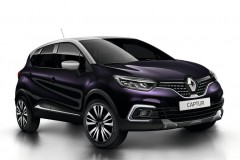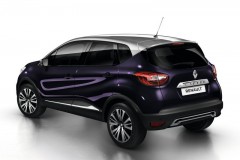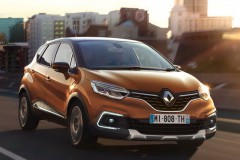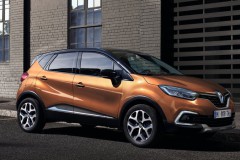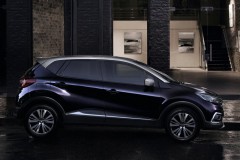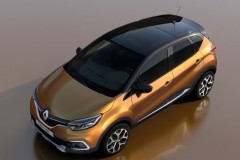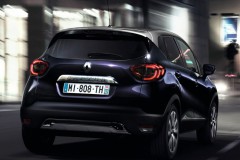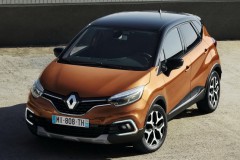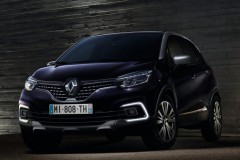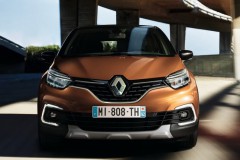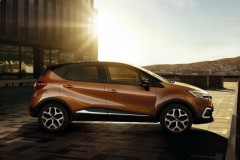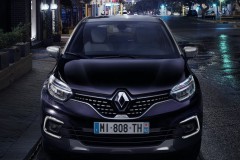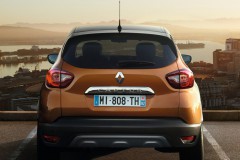Renault Captur 2017
Pretty!
Because it was bought by a woman, this was a very important criterion. Well, there is a certain French charm.
High: if the front bumper (the lowest point) is over, there will be no problem. Easy to get into, no "crawling" inside.
Powerful (110 diesel horses). If ECO mode is switched off, no problem accelerating.
If anyone is a fan of Greta Tunberg: the car takes care of the ecology, ...
read all Renault Captur reviews
This generation of Renault Captur has been produced from 2017 to 2019. We can provide information about 9 modifications of this generation. The car has been produced only with front wheel drive.
This Renault is available with three petrol engines with displacement from 0.9 to 1.3 litres and power of from 90 to 150 horsepower un one diesel engine with displacement 1.5 litres and power of from 90 to 110 horsepower.
The car is available with both manual (6 versions), as well as automatic (3 versions) gearbox.
Renault Captur 2017 average fuel consumption in combined cycle for petrol engine is from 5.1 to 5.6 litres per 100km, whereas for diesel engine - from 3.6 to 3.9 litres per 100km. The most fuel efficient Renault Captur 2017 petrol engine version is Renault Captur 0.9, consuming 5.1 litres per 100km. While the most fuel efficient Renault Captur 2017 diesel - Renault Captur 1.5 dCi for 100 kilometers consumes 3.6 liters of diesel.
Renault Captur 2017 CO2 emissions for petrol engine are from 113 to 125 grams per kilometer, but for diesel engine - approximately 101 grams per kilometer. From Renault Captur with petrol engines the lowest CO2 emissions has Renault Captur 0.9 which produces an average of 113 grams of CO2 per kilometer.
The best acceleration from 0 to 100 km/h - 8.2 seconds has Renault Captur S 1.3 TCe version, conversely the tardiest one is Renault Captur 1.5 dCi reaching this speed only in 13.8 seconds. The maximum top speed is 216 km/h for the 1.3 petrol 4-cylinder 150 hp version (Renault Captur S 1.3 TCe) and the 1.3 petrol 4-cylinder 150 hp version (Renault Captur S 1.3 TCe).
Lenght of Renault Captur is 412 cm, it is medium size car. Renault Captur gross weight is from 1671 to 1762 kg (depending on modification), which is approximately the same as the average for cars of this age and class.
This Renault is relatively cheap - it can be purchased (in Latvia, EU) for around 9000 €. Below you will find more detailed information about Renault Captur prices and costs.
Renault Captur modifications
| Modification | Engine | Power | Consumption | Gearbox |
|---|---|---|---|---|
|
Renault Captur 2017 0.9
Most fuel efficient petrol version |
0.9 Petrol | 90 HP | 5.1 l/100km | Manual (5) |
| Renault Captur 2017 1.2 Jan 2017 — Dec 2018 | 1.2 Petrol | 120 HP | 5.5 l/100km | Manual (6) |
| Renault Captur 2017 1.2 Jan 2017 — Dec 2018 | 1.2 Petrol | 120 HP | 5.5 l/100km | Automatic (6) |
| Renault Captur 2018 1.3 TCe Jan 2018 — Dec 2019 | 1.3 Petrol | 130 HP | 5.6 l/100km | Manual (6) |
|
Renault Captur 2018 S 1.3 TCe
Jan 2018 — Dec 2019 Most dynamic version - 100 km/h in 8.2 seconds |
1.3 Petrol | 150 HP | 5.4 l/100km | Manual (6) |
|
Renault Captur 2018 S 1.3 TCe
Jan 2018 — Dec 2019 Most powerfull petrol version (150 HP) |
1.3 Petrol | 150 HP | 5.3 l/100km | Automatic (6) |
|
Renault Captur 2017 1.5 dCi
Most fuel efficient diesel version |
1.5 Diesel | 90 HP | 3.6 l/100km | Manual (5) |
| Renault Captur 2017 1.5 dCi | 1.5 Diesel | 90 HP | 3.8 l/100km | Automatic |
|
Renault Captur 2017 1.5 DCi
Jan 2017 — Dec 2018 Most powerfull diesel version (110 HP) |
1.5 Diesel | 110 HP | 3.9 l/100km | Manual (6) |
Renault Captur prices
Renault Captur 2017 - 2019 crossover price in Latvia is from 6500 € to 11000 €.
Comparing to analogical vehicles Renault Captur price is very low - Renault Captur is approximately for 37 percents cheaper then average crossovers of this age (compare crossovers 2017 - 2019 prices). Despite of relatively low price Renault Captur quality is above average (see below), so this Renault can be a good buy.
| Year | Lowest | Average | Highest | Availability |
|---|---|---|---|---|
| Renault Captur 2019 price | 6500 € | 9000 € | 10 500 € | |
| Renault Captur 2018 price | 9000 € | 10 000 € | 11 000 € | |
| Renault Captur 2017 price | 9000 € | 9000 € | 9000 € |
Renault Captur total costs of ownership
How much really costs to own Renault Captur?
Renault Captur 2017 total costs of ownership calculator
Calculate total cost of ownership of the Renault Captur, including purchase, insurance, maintenance, taxes and other costs based on how you use your vehicle.
Renault Captur mileage
To estimate approximate Renault Captur mileage, please choose production year
2017 2018 2019

Check Vehicle's History
Access 300+ million damage records from 900+ data sources across 40+ countries.
Get 20% off your VIN check using this form!
Renault Captur reliability and quality
According to yearly reports of vehicle inspection service Renault Captur reliability is good. In the roadworthiness tests in 2022 defects were detected in an average of 4.3 percent of Renault Captur of this generation (on average 4 years old at the time of inspection). The average failure rate for a vehicles of the same age was 5.9%.
Renault Captur reliability and quality
Most reliable 7-9 year old used cars
Most reliable 7-9 year old used crossovers
Renault Captur 2017 features (options)
Percentage of Renault Captur with corresponding feature (option)
81% Rain sensor
73% Climate control
69% Tire pressure control
61% Metallic paint
42% Bi-xenon lights
12% Xenon headlights
11%
Renault Captur 2017 photo images
Similar cars to Renault Captur 2017
Cars similar and most compared to Renault Captur 2017. Click on the image to view the car's specifications or on the "Compare..." link to compare cars.
- petrol, diesel and LPG engines available
- available with 4x4 drive
- fewer faults
- lower fuel consumption
- lower price
- lower fuel consumption for petrol engines
- roomier boot
- available with 4x4 drive
- roomier boot
Renault Captur reviews
Find below reviews about other generations of Renault Captur.
Pros: Pretty!
Because it was bought by a woman, this was a very important criterion. Well, there is a certain French charm.
High: if the front bumper (the lowest point) is over, there will be no problem. Easy to get into, no "crawling" inside.
Powerful (110 diesel horses). If ECO mode is switched off, no problem accelerating.
If anyone is a fan of Greta Tunberg: the car takes care of the ecology, indicates when to change gear, does something else. But Greta's mode is deactivatable :)
Easy to drive: electric power steering with variable power steering: light steering at low speeds, firmer steering at higher speeds. The monitor shows the outside air quality: why I need it, I don't know, but it's interesting.
2-deck boot with full spare wheel.
Aluminium doors, plastic wings: low weight (and tax), less chance of rusting.
Cons: I don't really like climate control.
The multimedia system does not support Android Auto until 2016.
| Purchase year: | 2022 age of car 6 years) | Owned for | 6`000 kilometers (0 years) |
|---|---|---|---|
| Average fuel consumption: | 4.2 litres per 100km (40% urban driving) | ||
| Total cost of repairs: | 600 € | ||
Would recomend this car to the friend


